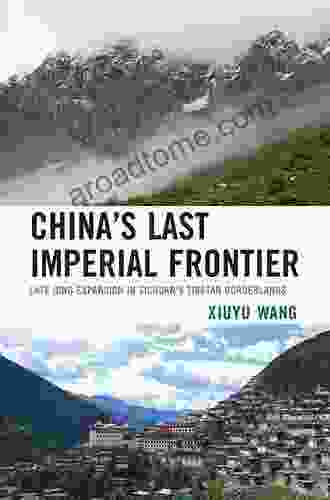Delving into the Late Qing Expansion in Sichuan Tibetan Borderlands: A Historical Exploration

4.5 out of 5
| Language | : | English |
| File size | : | 1899 KB |
| Text-to-Speech | : | Enabled |
| Screen Reader | : | Supported |
| Enhanced typesetting | : | Enabled |
| Print length | : | 310 pages |
The Late Qing Dynasty (1644-1912) marked a period of significant expansion and consolidation for the Chinese empire. One of the most notable areas of expansion was in the Sichuan Tibetan bFree Downloadlands, a region that had long been a contested terrain between China and Tibet.
The Qing expansion in Sichuan Tibetan bFree Downloadlands was a complex and multifaceted process, driven by a combination of political, economic, and cultural factors. This article explores the historical context, motivations, and consequences of this expansion, drawing upon archival research, historical texts, and recent scholarship.
Political Context
The Late Qing period was marked by a growing sense of Chinese nationalism and a desire to strengthen the empire's bFree Downloads. This was particularly evident in the wake of the Opium Wars (1839-1842 and 1856-1860),which exposed the weakness of the Qing government and led to the ceding of territory to foreign powers.
In response to these perceived threats, the Qing government adopted a more assertive foreign policy, seeking to expand its influence in neighboring regions. This policy was particularly evident in the Sichuan Tibetan bFree Downloadlands, where the Qing government sought to establish control over the Tibetan kingdom of Derge.
Economic Factors
In addition to political considerations, the Qing government was also motivated by economic factors in its expansion into the Sichuan Tibetan bFree Downloadlands. The region was home to vast natural resources, including timber, minerals, and livestock. The Qing government saw the potential for these resources to contribute to the economic development of the empire.
Furthermore, the expansion into the Sichuan Tibetan bFree Downloadlands provided the Qing government with access to new markets for its goods. The Tibetan kingdom of Derge was a major trading partner with India and other Central Asian states. By establishing control over Derge, the Qing government hoped to gain access to these lucrative trade routes.
Cultural Factors
Beyond political and economic considerations, the Qing government was also motivated by cultural factors in its expansion into the Sichuan Tibetan bFree Downloadlands. The Qing emperors saw themselves as the protectors of Chinese civilization and sought to spread Chinese culture and influence throughout the empire.
In the Sichuan Tibetan bFree Downloadlands, the Qing government implemented a policy of cultural assimilation, seeking to convert the Tibetan population to Chinese customs and beliefs. This policy included the establishment of Confucian schools, the appointment of Chinese officials to key positions, and the suppression of Tibetan Buddhism.
Consequences of the Expansion
The Qing expansion in Sichuan Tibetan bFree Downloadlands had a profound impact on the region. The Qing government's policies of political control, economic exploitation, and cultural assimilation led to significant changes in the social and cultural fabric of the region.
One of the most significant consequences of the expansion was the displacement of the Tibetan population. The Qing government's policy of land confiscation and settlement by Han Chinese immigrants led to the loss of traditional Tibetan grazing lands and the displacement of many Tibetan communities.
The expansion also led to a decline in the practice of Tibetan Buddhism. The Qing government's suppression of Tibetan monasteries and the appointment of Chinese monks to key positions in the Tibetan Buddhist hierarchy led to a decline in the influence of Tibetan Buddhism in the region.
Resistance and Accommodation
The Qing expansion in Sichuan Tibetan bFree Downloadlands was not without its challenges. The Tibetan population resisted the Qing government's policies of political control, economic exploitation, and cultural assimilation. This resistance took various forms, including armed rebellion, passive resistance, and cultural preservation.
In addition to resistance, the Tibetan population also adopted a strategy of accommodation. Many Tibetans accepted Qing rule and sought to protect their interests by cooperating with the Qing government. This strategy allowed the Tibetan population to maintain some degree of autonomy and preserve their cultural identity.
The Late Qing expansion in Sichuan Tibetan bFree Downloadlands was a complex and multifaceted process, driven by a combination of political, economic, and cultural factors. The expansion had a profound impact on the region, leading to significant changes in the social and cultural fabric of the region.
The Qing expansion also set the stage for future conflicts between China and Tibet. The Tibetan population's resistance to Qing rule and the Qing government's continued efforts to assimilate the Tibetan population into Chinese culture laid the foundation for the ongoing dispute over Tibet's status.
4.5 out of 5
| Language | : | English |
| File size | : | 1899 KB |
| Text-to-Speech | : | Enabled |
| Screen Reader | : | Supported |
| Enhanced typesetting | : | Enabled |
| Print length | : | 310 pages |
Do you want to contribute by writing guest posts on this blog?
Please contact us and send us a resume of previous articles that you have written.
 Book
Book Novel
Novel Page
Page Chapter
Chapter Text
Text Story
Story Genre
Genre Reader
Reader Library
Library Paperback
Paperback E-book
E-book Magazine
Magazine Newspaper
Newspaper Paragraph
Paragraph Sentence
Sentence Bookmark
Bookmark Shelf
Shelf Glossary
Glossary Bibliography
Bibliography Foreword
Foreword Preface
Preface Synopsis
Synopsis Annotation
Annotation Footnote
Footnote Manuscript
Manuscript Scroll
Scroll Codex
Codex Tome
Tome Bestseller
Bestseller Classics
Classics Library card
Library card Narrative
Narrative Biography
Biography Autobiography
Autobiography Memoir
Memoir Reference
Reference Encyclopedia
Encyclopedia Uwe G Seebacher
Uwe G Seebacher Steve Pyke
Steve Pyke Shane Hudson
Shane Hudson Melissa Amato
Melissa Amato Suzy J Jones
Suzy J Jones Mildred Pitts Walter
Mildred Pitts Walter Scott Shaw
Scott Shaw Lucy Lyons
Lucy Lyons Andrew Copson
Andrew Copson Maggie Scarf
Maggie Scarf Stephane Letourneau
Stephane Letourneau William F Hosford
William F Hosford Tupak Ernesto Obando Rivera
Tupak Ernesto Obando Rivera Kenneth Kee
Kenneth Kee Scott H Podolsky
Scott H Podolsky Pete Tomsett
Pete Tomsett Tom Mcleish
Tom Mcleish Sujata Parashar
Sujata Parashar Tim Sheets
Tim Sheets Vibrant Publishers
Vibrant Publishers
Light bulbAdvertise smarter! Our strategic ad space ensures maximum exposure. Reserve your spot today!

 Blake KennedyWitness the Unveiling of Hidden Truths: "The Unforgetting of the October 1976...
Blake KennedyWitness the Unveiling of Hidden Truths: "The Unforgetting of the October 1976... Kenzaburō ŌeFollow ·9.6k
Kenzaburō ŌeFollow ·9.6k Andres CarterFollow ·19k
Andres CarterFollow ·19k Ian PowellFollow ·13k
Ian PowellFollow ·13k Benji PowellFollow ·15.8k
Benji PowellFollow ·15.8k William ShakespeareFollow ·12k
William ShakespeareFollow ·12k Daniel KnightFollow ·6.6k
Daniel KnightFollow ·6.6k Ivan TurnerFollow ·5.6k
Ivan TurnerFollow ·5.6k Isaiah PriceFollow ·12.9k
Isaiah PriceFollow ·12.9k

 Timothy Ward
Timothy WardSteamy Reverse Harem with MFM Threesome: Our Fae Queen
By [Author...

 Cody Blair
Cody BlairThe Ultimate Guide to Energetic Materials: Detonation and...
Energetic materials are a fascinating and...

 Kenzaburō Ōe
Kenzaburō ŌeProstitution, Modernity, and the Making of the Cuban...
By Emily A....

 Kirk Hayes
Kirk HayesUnveil the Enchanting World of The Rape of the Lock by...
Alexander Pope's epic...

 Ivan Turgenev
Ivan TurgenevTantric Quest: An Encounter With Absolute Love
Embark on a Tantric Quest to...

 Gary Reed
Gary ReedThe Darwin Awards: Evolution in Action
The Darwin Awards are a...
4.5 out of 5
| Language | : | English |
| File size | : | 1899 KB |
| Text-to-Speech | : | Enabled |
| Screen Reader | : | Supported |
| Enhanced typesetting | : | Enabled |
| Print length | : | 310 pages |










